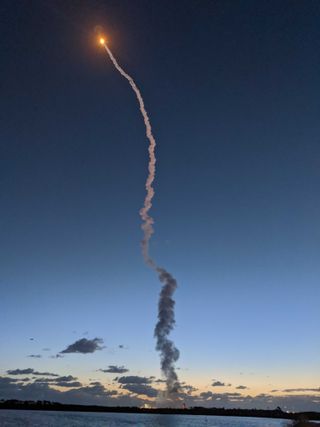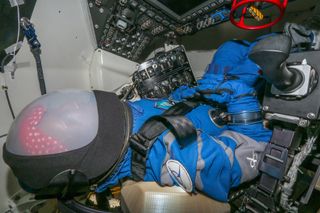Update for 7:20 a.m. ET: Boeing has delayed Starliner's orbit insertion burn because the spacecraft is not at the correct attitude, or orientation. Starliner is in a stable orbit, however, and the team is now working on next steps to correct Starliner's attitude before they can put it in the correct orbit. Stay tuned for more updates.
CAPE CANAVERAL, Fla. — Boeing's reusable CST-100 Starliner spacecraft launched on its first uncrewed test flight to the International Space Station today (Dec. 20).
At 6:36 a.m. EST (1136 GMT) this morning, the CST-100 Starliner capsule launched atop the United Launch Alliance "N22" Atlas V rocket (N22 is a new version of the Atlas V that has no fairing, two solid rocket boosters and two engines on the vehicle's Centaur upper stage). It lifted off from Space Launch Complex 41 at Florida's Cape Canaveral Air Force Station in the morning twilight, about half an hour before sunrise, making for a visually stunning event.
The vehicle launched with 595 lbs. (270 kilograms) of cargo on board, including holiday gifts for the astronauts of Expedition 61, radiation testing hardware and an anthropometric test dummy named Rosie.
Video: Blastoff! Boeing's Starliner Crew Capsule Launches to Space Station
Related: Boeing's 1st Starliner Flight Test in Photos

"Liftoff! The rise of Starliner and a new era of human spaceflight," a Boeing spokesperson said during a live webcast of today's launch.
"It was stunning to see," NASA spokesperson Marie Lewis added. "We could feel the rumble."
This mission, known as the Orbital Flight Test (OFT), will serve as a dress rehearsal for crewed Starliner missions, which are tentatively scheduled to begin sometime in 2020. The rocket took off without a hitch, soaring toward space and successfully and safely beginning its journey to the space station.

Nearly 26 hours following liftoff, the Starliner spacecraft is scheduled dock with the space station, where astronauts will begin bringing its cargo on board. It will spend about a week in space before making a short, approximately 4-hour, trip back to Earth and landing at the White Sands Missile Range in New Mexico, on Dec. 28.
The cargo on board Starliner today contains clothing, food, radiation monitoring equipment, some holiday presents for the six crewmembers on board the station and an anthropometric test device (ATD) or flight test dummy named "Rosie the Astronaut," or just Rosie for short. The test device, named after Rosie the Riveter, an inspirational figure for working women during World War II (and still today), is equipped with a number of special sensors that will collect data to inform Boeing and NASA about how Starliner's journey to and from space will likely affect future human crewmembers.
The capsule's cargo also contains commemorative items that, after returning from space, will be distributed to people across the country who helped to make this successful mission possible. Among the items are American flags, Starliner coins, Starliner program decals and a handful of other unique items.

OFT is "the first step in this next venture for commercial crew, especially the Starliner," NASA Administrator Jim Bridenstine said Thursday (Dec. 19) during a news conference at NASA's Kennedy Space Center in Florida. Following OFT, Boeing will launch the Crew Flight Test (CFT), the first-ever crewed Starliner mission, which will send NASA astronauts Michael Fincke and Nicole Mann and Boeing astronaut Chris Ferguson to the space station.
"We consider this a dress rehearsal for CFT," Pat Forrester, head of NASA's Astronaut Office, said at a news conference on Tuesday (Dec. 17). Following the first crewed trip on Starliner, NASA astronauts Suni Williams and Josh Cassada will fly as part of Starliner's first operational mission. Starliner, a reusable capsule, will be refurbished and updated after each landing before sending the next crew up to space.
"We have more under development right now than at any point in NASA's history," Bridenstine said. "We have two commercial crew programs that are under development and, of course, we've got our big program, which is going back to the moon under the title Artemis, where we're going to send the first woman and the next man to the south pole of the moon within five years."
In 2014, NASA chose commercial space companies Boeing and SpaceX to develop commercial spaceflight vehicles to ferry astronauts to and from the International Space Station. SpaceX completed the first uncrewed test flight of its Crew Dragon spacecraft in March, in a weeklong mission called Demo 1 that was similar to Starliner's OFT mission. The Crew Dragon is currently scheduled for its first crewed flight to the space station in February.
Boeing's Starliner and SpaceX's Crew Dragon will decrease NASA's dependence on Russia's Soyuz spacecraft to send humans to the space station and, for the first time since the last space shuttle flight in 2011, launch astronauts from American soil.
"When we start launching into space, it's going to be a great time to be an American, because we are going to, in fact, launch American astronauts on American rockets from American soil for the first time since the retirement of the space shuttle," Bridenstine added at the briefing, repeating a line that has become such a staple in NASA's vision for human spaceflight that Bridenstine noticed a member of the audience mouthing the words along with him. "I see you mouthing the words because I'm gonna keep saying it, it's overdue!" Bridenstine said.
Follow Chelsea Gohd on Twitter @chelsea_gohd. Follow us on Twitter @Spacedotcom and on Facebook.

"space" - Google News
December 20, 2019 at 07:08PM
https://ift.tt/2EB678z
Boeing Starliner Spacecraft Launches on Historic 1st Mission to Space Station - Space.com
"space" - Google News
https://ift.tt/2Q8TIzF
Shoes Man Tutorial
Pos News Update
Meme Update
Korean Entertainment News
Japan News Update
Bagikan Berita Ini
















0 Response to "Boeing Starliner Spacecraft Launches on Historic 1st Mission to Space Station - Space.com"
Post a Comment